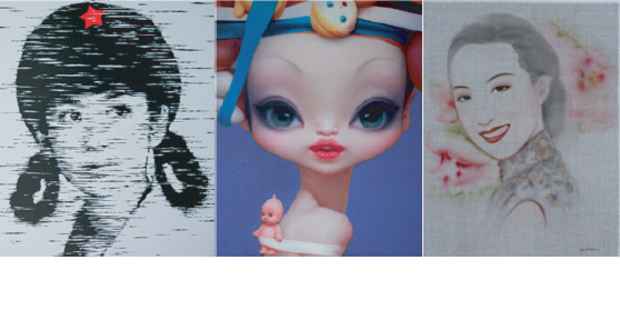Song Ying, Wang Zhijie and Ma Yanling “Feminine Icons”
Tenri Cultural Institute

This event has ended.
TENRI CULTURAL INSTITUTE presents the exhibition Feminine Icons: Song Ying, Wang Zhijie, Ma Yanling in collaboration with Cristal Kim’s Asian Art Works Gallery, in Beijing. The exhibition features three Song Ying, Wang Zhijie, and Ma Yanling who take inspiration for their works from modern iconic females.
Wang Zhijie uses popular feminine stereotypes of entertainers, models, fashionistas, sex kittens, and wealthy misses as his sitters. But, he lampoons the very stereotypes he is accessing to create animation-like characters of women in roles that society envisages as stereotypes. A good example is Girl 13-17 in which a female entertainer it about to sing into a microphone. Her platinum hair is set into marcel waves and her blue eyes are offset against a pale skin tone and pink colored full lips. Her eyes are highly painted and her brows have been plucked into high curving arches. Though her head is exaggeratedly large according to cartooning precepts, by contrast as her skirt evinces, her lithe body is in movement. Wang’s girls should be fashion conscious, wear make-up, be entertaining, sexy, fashionable, and playful.
Ma Yanling paints icons from Chinese theater and film of which Zhou Xuan (August 1, 1918 or 1920 – September 22, 1957), is one iconic Chinese singer and film actress. By the 1940s, she had become one of China’s seven great singing stars. Called the “Golden Voice” Zhou sang and recorded an abundance of songs and acted in over 40 films. She sang her high pitched songs melodiously and became the most famous and popular singer in China but, the songstress died tragically of encephalitis at age 37. Ma’s depictions of the actress convey her soft femininity, and as another of Ma’s paintings Elixir of Love suggests, her ability to bewitch men with her beauty and sexual power. Ma produces imagery of western movie stars as well as seen in his Marilyn Monroe and Audrey Hepburn that are idealized portraits created upon a fine linear grid imbuing the sitters with a soft melodramatic quality.
Song Ying creates imagery of girls in army uniforms wearing hats with red stars on them. These innocent sweet girls are seen as if on a 50s television program with white snow interference. By so presenting them perhaps Song is commenting on bygone times in Maoist China (1949-76) when young people wore military uniforms and hats with red stars. Juxtaposed against the sweetness of the young girls’ faces these plain monochrome suits relieved only by the red stars act as neutral backdrops. These youngsters appear as if they belong in those huge engineered pageants celebrating communist rule that include goose-stepping soldiers. And perhaps they would have held colored placards with political messages such as “We serve the people”. Style-wise, Song’s work has something of Gerhard Richter’s soft painterly quality of the abstract period (1990-1994) in which he dragged the paint across the canvas to produce horizontal patterns except that in this respect Song’s works are representational rather than abstract. These three artists from China offer us iconic images of the female; ironizing, recalling, reminiscing, thinking back, or commenting or commemorating and evoking the distant past and at times even reestablishing new icons.
Media
Schedule
from December 02, 2014 to December 23, 2014
Opening Reception on 2014-12-02 from 18:00 to 20:00